When considering a roof upgrade, many homeowners wonder, “Can you lay metal roofing over shingles?” This question is crucial for those looking to enhance their home’s durability and appearance without the hassle of a complete roof tear-off. In this comprehensive guide, we’ll explore whether this approach is feasible, its benefits, potential challenges, and what you need to know before making a decision.

Why Consider Metal Roofing Over Shingles?
Durability and Longevity
Metal roofing is renowned for its durability and longevity. Unlike traditional shingles that may need replacing every 20 years, metal roofs can last 50 years or more with proper maintenance. This longevity makes metal roofing a cost-effective option in the long run.
Energy Efficiency
Metal roofs reflect solar radiant heat, which can reduce cooling costs by 10-25%. This energy efficiency is particularly beneficial in warmer climates where cooling expenses can be significant.
Read too: Decoding Timelines: How Long Does It Take To Replace A Roof and What to Expect
Aesthetic Appeal
Metal roofing comes in various styles and colors, offering an attractive alternative to traditional shingles. Whether you prefer the look of standing seam panels or metal shingles, there are options to suit almost any architectural style.
Can You Lay Metal Roofing Over Shingles?
Understanding the Basics
Yes, you can lay metal roofing over shingles. However, there are important considerations and steps to follow to ensure a successful installation. The existing roof must be in relatively good condition, free of major structural issues, and able to support the additional weight of the metal roofing.
Benefits of Laying Metal Roofing Over Shingles
Cost Savings
One of the primary benefits of installing metal roofing over shingles is cost savings. By avoiding the tear-off process, you save on labor and disposal costs associated with removing the old shingles.
Reduced Installation Time
Since there’s no need to remove the existing shingles, the installation process is quicker, minimizing disruption to your home.
Environmental Benefits
By keeping the old shingles in place, you reduce waste sent to landfills. Additionally, metal roofing is often made from recycled materials and is 100% recyclable at the end of its life.
Key Considerations and Preparations
Inspecting the Existing Roof
Before proceeding, have a professional roofer inspect your existing shingle roof. The inspection should check for any signs of damage, moisture, or structural issues that could affect the new metal roof.
Underlayment
A high-quality underlayment is essential when installing metal roofing over shingles. The underlayment acts as a barrier, preventing moisture from reaching the shingles and providing an extra layer of protection.
Ventilation
Proper ventilation is crucial to prevent moisture buildup and ensure the longevity of your roof. Discuss ventilation options with your roofer, such as adding ridge vents or soffit vents, to maintain adequate airflow.
Weight Considerations
While metal roofing is lightweight, the combined weight of the shingles and metal panels should be evaluated. Most homes can support the additional weight, but it’s important to confirm this with a structural engineer if there are any doubts.
Step-by-Step Guide to Installation
Step 1: Prepare the Roof Surface
Ensure the existing shingles are flat and securely attached. Remove any loose or damaged shingles and nail down any protruding nails. Clean the roof surface to remove debris and dirt.
Step 2: Install the Underlayment
Lay a high-quality underlayment over the existing shingles. This underlayment acts as a moisture barrier and provides a smooth surface for the metal roofing.
Step 3: Add Furring Strips (Optional)
In some cases, furring strips (also known as battens) are installed over the underlayment to create a vented air space between the shingles and the metal roofing. This can improve ventilation and energy efficiency.
Step 4: Install the Metal Panels
Starting at the eaves, lay the metal panels, overlapping each panel according to the manufacturer’s instructions. Secure the panels with appropriate fasteners, ensuring they are tight but not overdriven, which can damage the panels.
Step 5: Finish with Trim and Flashing
Install the necessary trim and flashing to complete the roof. This includes ridge caps, edge trim, and flashing around roof penetrations like chimneys and vents. Proper installation of these components is crucial to prevent leaks.
Potential Challenges
Uneven Surface
Installing metal roofing over uneven or damaged shingles can result in a less smooth appearance and potential issues with the roof’s integrity. Ensure the shingle roof is as flat as possible before installation.
Building Codes and Permits
Check local building codes and regulations before proceeding. Some areas may have restrictions or requirements for installing a new roof over an existing one. Additionally, obtaining the necessary permits is essential to avoid future legal issues.
Noise
Metal roofs can be noisier during rain or hailstorms compared to traditional shingles. Installing insulation or sound-deadening materials can mitigate this issue.
Moisture Trapping
If not properly installed, laying metal roofing over shingles can trap moisture, leading to mold and rot. Ensuring proper ventilation and using a high-quality underlayment can help prevent this problem.
Conclusion
So, can you lay metal roofing over shingles? The answer is yes, but it requires careful planning, professional inspection, and proper installation techniques. By following the guidelines outlined in this article, you can enjoy the benefits of a durable, energy-efficient, and aesthetically pleasing metal roof without the added expense and hassle of removing your existing shingle roof. Always consult with professional roofers to ensure the job is done correctly and safely.



Leave a Reply